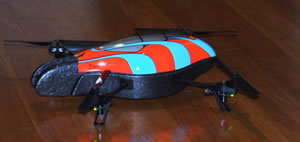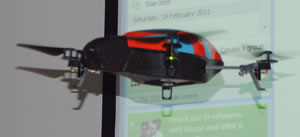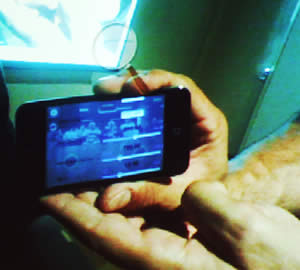Monthly Main Meeting Highlights
February 2011 Main Meeting:
Welcome to the February Main Meeting.
and the amazing Parrot AR Drone.

Mark from AR Drone was on stage to give this quadricopter a full workout
for the group.

This is no toy helicopter. In the words of Henri Seydoux, CEO of Parrot
“It’s the world’s first unmanned aerial vehicle”.
This is a camera-carrying cross between a military drone and a sophisticated
radio controlled flying model. I believe it could have applications well
beyond simple game playing. It was interesting to note that two Drones
have been purchased for possible use in cliff reconnaissance prior to
dispatching a rescue team for stranded climbers.
Out of the box, Mark took only a minute to place the battery in the Drone
and fit the indoor protective polystyrene outer rim.

This is the main body of the unit with battery unit attached. The camera can be seen at the front of the vehicle
The drone comes in two incarnations –


indoor, and outdoor.
both in the same box with it's own landing field.

Indoor flight uses a simple guard to protect the propellers while outside
a small canopy is used for better aerodynamics.

Indoor flight mode.

Flying in outside mode, the propellers are exposed to allow for maximum thrust.

The force of the downdraft can be seen in the way my note pad is unfolding.

Mark is pointing out the sensors that allow the AR Drone to determine
its height.
The sophistication of the controls of this device is outstanding.
Designed to be operated with the iPhone, iPad or iPod Touch, its operating
system uses a three axis accelerometer to allow the controller to adjust
pitch and yew simply by tilting the controller.
The sensitivity of the controls is adjusted using a simple slide bar.

There are several videos on the web showing the Drone in flight.
This one from the AR Drone site shows both the controller and the fight.
Technical details
The Parrot has an onboard computer with Parrot’s own P6 CPU with ARM926
core 32 bit, 468 MHz processor, 128 DDR memory and 128 MB flash memory
with a USB interface.
The computer uses a sensor array of altimeter, three gyroscopes, and cameras
in the front and underneath of the machine to help the pilot control its
flight.
The altimeter is an ultrasound device with a 6 metre range. There are
three Gyroscopes. Two MEMS (Microelectromechanical systems) sensor 2 axis
(XY) and a precision axis gyroscope (Z).
Radio-Control planes, helicopters, etc, only have a radio receiver to
move the various control surfaces such as rudder and elevators. This requires
the controller’s full attention. Any distraction and the machine crashes.
The AR Drone will simply hover until the controller returns his attention
to flying, so a phone call on the iPhone should not cause a disaster.
Software to run the AR Drone is open source. In the AR Drones’ Developers
zone programmers and game developers can sign up and “you keep 100% of
the revenue sales of your AR DRONE compatible applications”.
Purchase and repair
With most RC controlled planes a crash landing means building a new model,
however the AR Drone has replacement parts for virtually every item from
propellers to body shells.
The list is available from AR Drone’s front page along with video tutorials
and other information.
http://ardrone.com.au/
In Australia the AR Drone is available from Telstra shops at $349.
Mark recommended purchase from the Telstra shop rather than online as delivery and warranty repairs with online purchases could take weeks. The reason being that online, the Drone is supplied direct from France, where it is manufactured.
Game Playing
The AR Drone is sold as an Augmented Reality game device. You can fight
aliens in the lounge room or join with other Drone pilots in wild dog
fights. The onboard cameras are fed into the screen so the pilot receives
a live feed of the Drone’s position even if it is out of the operator’s
line of sight.
Here is the link to Parrot’s
games applications site
I also found some in ilouge
including an app to record the cameras.
and of course Apples
iTune store
The Raffle
Tonight we had a varied selection of both soft- and hardware on offer.

with
Warren Wylie

Taking home Version 5 of Norton 360.

Phillip Soller with Web Root Anti virus software

Rodger Foulds took home the Sandisk USB Stick

Joan Robertson took home the AMD insulated cup,

Frank Bowman with the Tech-Ed water bottle

Allan Matthews will be typing away on his new Microsoft Keyboard and Mouse.

and Peter Collard took home the door prize.
